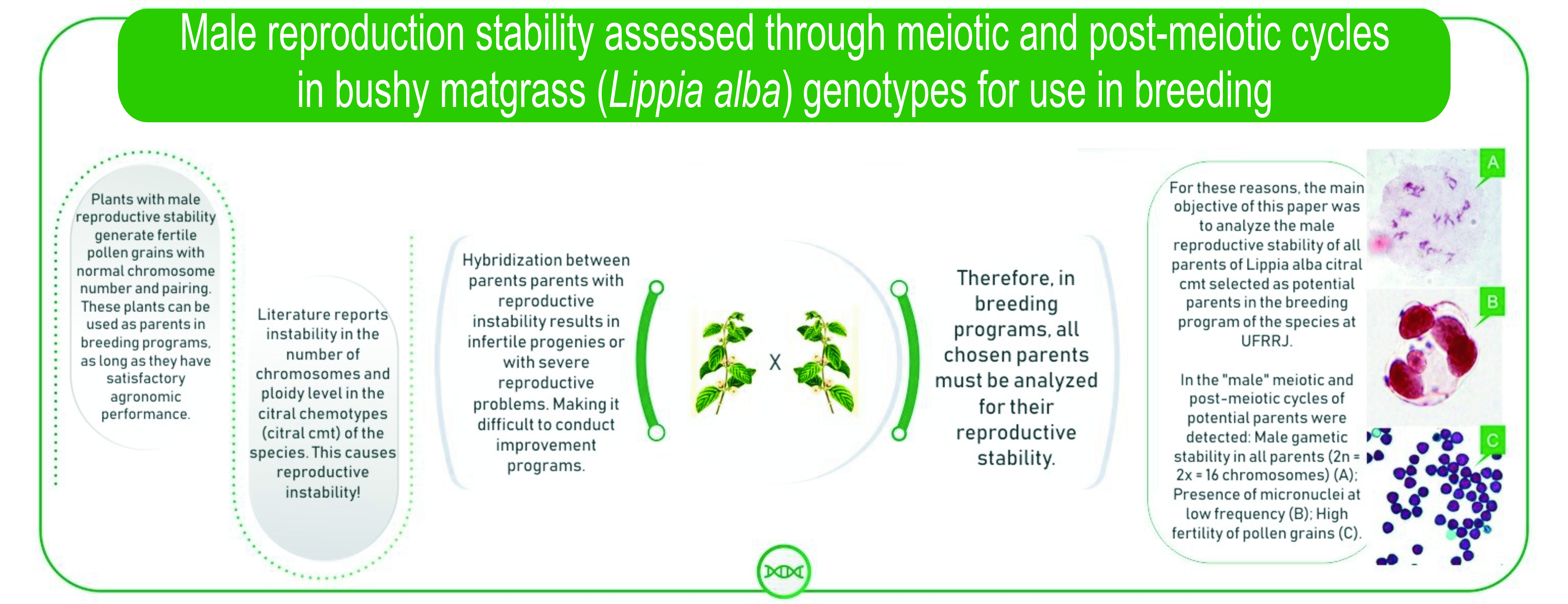Male reproduction stability assessed through meiotic and post-meiotic cycles in bushy matgrass (Lippia alba) genotypes for use in breeding
DOI:
https://doi.org/10.70151/vxx57d74Keywords:
chromosome number, ploidy level, meiotic index, pollen grain viability, genetic parametersAbstract
The aim of the present study is to analyze the meiotic and post-meiotic cycles of bushy matgrass genotypes (citral chemotype) in order to better understand their respective male reproduction stability. It is essential estimating such a stability when a non-domesticated species is selected. Therefore, the number of chromosomes of pollen-mother cells, and their ploidy were assessed; possible meiosis anomalies were assessed. Recombination index (RI) was estimated. The number of normal and abnormal post-meiotic products (PM’s) was counted. Meiotic index (MI) and pollen grain viability (VIA) were estimated. These estimates were carried out per genotype and they were subjected to ANOVA and to average tests. All genotypes were diploid (2n = 30 chromosomes). Pairing was quite regular (RI = 44.33%). Meiotic cycle anomalies recorded very low frequency rates. Assumingly, chromosomal breaks resulted from micronuclei formation in PM’s. Estimated MI was 94.48%, and estimated VIA was 94.32%. MI and Via did not statistically differ between genotypes. These outcomes point towards genotypes’ high male reproduction stability and to the significant influence of genetic effects on MI and VIA.
Downloads
References
Alexander MP (1969) Differential staining of aborted and no aborted pollen. Stain Technology 44:117-122. http://doi.org/10.3109/10520296909063335
Brasil. 2021a. Ministério da Agricultura, Pecuária e Abastecimento (MAPA). Cultivar web - Gerenciamento de Informação. URL: http://sistemas.agricultura.gov.br/snpc/cultivarweb/cultivares_protegidas.php(Accessed 1.7.21).
Brandão AD, Viccini LV, Recco-Pimentel SM (2005) Meiotic analysis of two putative polyploidy species of Verbenaceae from Brazil. Caryologia 58:315-319. http://doi.org/10.1080/00087114.2005.10589469
Brandão AD, Viccini LF, Salimena FRG, Vanzela ALL, Recco-Pimentel SM (2007) Cytogenetic characterization of Lippia alba and Lantana camara (Verbenaceae) from Brazil. J Plant Res 120:317–321. http://doi.org/10.1007/s10265-006-0041-4
Carvalho DF, Silva LDB, Folegatti MV, Costa JR, Cruz FA (2006) Avaliação da evapotranspiração de referência na região de Seropédica-RJ, utilizando lisímetro de pesagem. Rev Bras Agrometeorol 14:108-116.
Cruz CD (2016) Genes Software – extended and integrated with the R, Matlab and Selegen. Acta Scient Agron 38:547-552.
Damasceno Junior PC, Pereira TNS, Neto MF, Pereira MG (2010)Meiotic behavior of Carica papaya and Vasconcellea monoica. Caryologia 63:229-236. http://doi.org/10.1080/00087114.2010.10589732
Darlington CD (1958) Evolution of genetic systems. Second Edition: Oliver and Boyd Edinburgh, 266 p.
Lopes JML, de Carvalho HH, Zorzatto C, Azevedo ALS, Machado MA, Salimena FRG, Grazul RM, Gitzendanner MA, Soltis DE, Soltis PS, Viccini LF (2020) Genetic relationships and polyploid origins in the Lippia alba complex. Am J Bot 107:1–11. http://doi.org/10.1002/ajb2.1443
Love RM (1951) Varietal differences in meiotic chromosomes behavior of Brazilian wheats. Agron J 43:72-76. http://doi.org/10.2134/agronj1951.00021962004300020005x
MalallahGA, Attia TA, Masood M (2001) Aneuploidy in wild Picris babylonica (Asteraceae) in Kuwait. Cytologia 66:241-246. http://doi.org/10.1508/cytologia.66.241
Pierre PMO, Sousa SM, Davide LC, Machado MA, VicciniLF (2011) Karyotype analysis, DNA content and molecular screening in Lippia alba (Verbenaceae). An Acad Bras Cienc 83:993-1005. http://doi.org/10.1590/S0001-37652011005000012
Reis AC, Sousa SM, Vale AA, Pierre PMO, Franco AL, Campos JMS, Vieira RF,VicciniLF (2014) Lippia alba (Verbenaceae): a new tropical autopolyploid complex? Am J Bot 101:1002–1012. http://doi.org/10.3732/ajb.1400149
Salimena FRG, Múlgura ME (2015) Notas taxonômicas em Verbenaceae do Brasil. Rodriguésia 66:191-197. http://doi.org/10.1590/2175-7860201566110
Senda T, HiraokaY, Tominaga T (2005) Cytological affinities and interfertilities between Lolium temulentum and L. persicum (Poaceae) accessions. Hereditas 142:45-50. http://doi.org/10.1111/j.1601-5223.2005.01908.x
Singhal VK, Kumar P (2008) Impact of cytomixis on meiosis, pollen viability and pollen size in wild populations of Himalayan poppy (Meconopsis aculeate Royle). J Biosci 33:371–380. http://doi.org/10.1007/s12038-008-0057-0
Soares CH do N, Damasceno Junior PC, Campos IM, Amorim GTS, Carmo MGF, Chaves DAS, Souza MAA (2019) Selection of genotypes (citral chemotype) of Lippia alba (Mill.) N. E. Brown regarding seasonal stability of the essential oils chemical profile. Ind Crops Prod 139:1-8. http://doi.org/10.1016/j.indcrop.2019.111497
Sousa MS, Silva PS, Torres GA, Viccini LF (2009) Chromosome banding and essential oils composition of Brazilian accessions of Lippia alba (Verbenaceae). Biologia 64:711-715. http://doi.org/10.2478/s11756-009-0066-y
Tareau MA, Palisse M, Odonne G (2017) As vivid as a weed… Medicinal and cosmetic plant uses amongst the urban youth in French Guiana. J Ethnopharmacol 203:200–213. http://doi.org/10.1016/j.jep.2017.03.031
Viccini LF, Silveira RS, Vale AA, Campos JMS, Reis AC, Santos MO, Campos VR, Carpanez AG, Grazul RM (2014) Citral and linalool content has been correlated to DNA content in Lippia alba (Mill.) N.E. Brown (Verbenaceae). Ind Crops Prod 59:14–19. http://doi.org/10.1016/j.indcrop.2014.04.028
Zamariola L, Tiang CL, Storme ND, Pawlowski W, Geelen D (2014) Chromosome segregation in plant meiosis. Front Plant Sci5:1-19. http://doi.org/10.3389/fpls.2014.00279

Downloads
Published
Issue
Section
License

This work is licensed under a Creative Commons Attribution-NonCommercial-NoDerivatives 4.0 International License.

